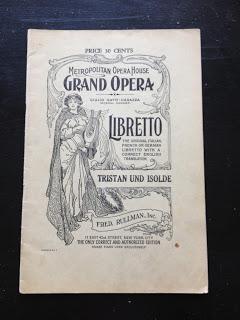 In about a month's time, I will see the Met's new Tristan und Isolde with my mother (her conversion from opera-skeptic to budding Wagnerite is chronicled here.) We're both very excited. After I described the plot to her, she said she thought she'd like to look at the words, and asked if they were printed anywhere. I joyfully assured her that they were, and promised to lend her my libretto. In digging it out of my untidy collection, I discovered that I own not the modern red-and-white edition, but something far more interesting: this fabulous artifact. It includes a full-page endorsement of Knabe pianos by Göta Ljungberg, and a deliberately archaic English translation, oddly sprinkled with pseudo-medievalism. ("O, er weiss wohl warum!" becomes "Oh! he wots well the cause.") The missteps may be many, but Isolde's contemplation of the waves in the Liebestod, asking "Shall I sip them, / dive within them, / to my panting / breathing win them?" struck me as surprisingly effective in its ecstatic eroticism.
In about a month's time, I will see the Met's new Tristan und Isolde with my mother (her conversion from opera-skeptic to budding Wagnerite is chronicled here.) We're both very excited. After I described the plot to her, she said she thought she'd like to look at the words, and asked if they were printed anywhere. I joyfully assured her that they were, and promised to lend her my libretto. In digging it out of my untidy collection, I discovered that I own not the modern red-and-white edition, but something far more interesting: this fabulous artifact. It includes a full-page endorsement of Knabe pianos by Göta Ljungberg, and a deliberately archaic English translation, oddly sprinkled with pseudo-medievalism. ("O, er weiss wohl warum!" becomes "Oh! he wots well the cause.") The missteps may be many, but Isolde's contemplation of the waves in the Liebestod, asking "Shall I sip them, / dive within them, / to my panting / breathing win them?" struck me as surprisingly effective in its ecstatic eroticism.The libretto also includes an "extra": a piano version of the Liebesnacht! I was fascinated by this, richly evocative of an audience expected to have the skills and desire to take the music home with them in this way, whether to an upright piano in a corner or to a far grander instrument and leisure to play it in. But even more interesting to me was the note by the libretto's first owner: "March 16, 1934 -- At the Metropolitan with my most beloved cousin -- The greatest performance -- Tristan + Isolde / Henry + Julie Grün."

Henry's praise of this as "The greatest performance--" intrigued me. Since I also have his libretto for Lucia di Lammermoor, I could compare his style as a commenter; that performance counted only as "a quite enjoyable evening." A search in the Met database revealed only modified raptures from the surviving review by Wagnerian W.J. Henderson, making me even more glad of Henry's note.
The Tristan, Paul Althouse, was singled out as the first American to perform the role at the Met. (Thanks to the wonders of YouTube, you can hear Althouse singing Wagner here.) The reviewer for the Sun noted that Althouse "knew his score, costumed and made up the part well, was a dignified and histrionically commendable knight, and sang his music with intelligence, feeling, and good enunciation of the text." I was fascinated to see this degree of interest in how singers looked their parts, sometimes condemned as a peculiarly contemporary failing. There were surprises in the other direction, too, as Henderson not only praises Althouse as "histrionically commendable" (my new favorite review phrase) but condemns the stage blocking of Act I for its lack of dramatic plausibility, as Brangäne stood "away across the stage and apparently not interested in the matter."
The Isolde who so impressed Henry (and the reviewer) turned out to be none other than Frida Leider! Her performance was praised as "rich in beauty and artistic detail." I was stunned to find a live recording of her singing the Liebestod at the Met:
I like to think that Henry would be pleased to learn of all the ways in which technology has enabled records of opera to survive... and, as an inveterate chronicler of personal impressions of the opera, I'm delighted to know that this performance, not singled out in Tristan und Isolde's performance annals, was, for Henry and Julie, "the greatest."

